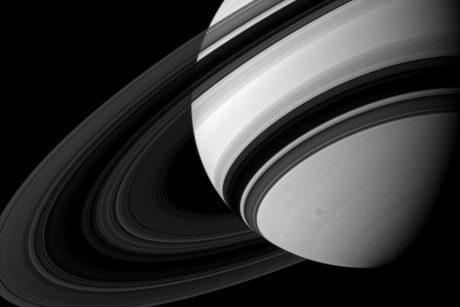After examining hidden density waves from Saturn’s B-ring – the largest of the planet’s awe-inspiring, cosmic bands – astronomers confirm that this circular object is as lightweight as it is opaque. Their findings are published online in the journal Icarus.
Philip Nicholson, Cornell professor of astronomy, and lead author Matthew Hedman, a University of Idaho professor of physics and a former senior research associate at Cornell, found no correlation between ring opacity and the amount of material (mass per unit area) it contains. In their study, “The B-ring’s surface mass density from hidden density waves: Less than meets the eye?,” the opacity of the B-ring varied by a large amount across its width, but its mass (amount of material) did not change.
An earlier study by the Cassini mission composite infrared spectrometer team suggested there was less material in the B-ring than researchers previously believed. This new analysis is the first to directly measure the density of mass in the ring, according to NASA.
“Appearances can be deceiving,” said Nicholson. “A good analogy is how a foggy meadow is much more opaque than a swimming pool, even though the pool is more dense and contains a lot more water.”
Saturn’s rings are gigantic structures with a diameter of about 170,000 miles. The B-ring – bright and reflective on one side, dark, mysterious and opaque on the other – is about 15,800 miles wide, while its thickness is about 30 feet.
Hedman and Nicholson “weighed” the nearly opaque center of the B-ring by analyzing spiral density waves – fine-scale features created by gravitational tugs on ring particles. To obtain the density of the B-ring, the scientists used data from the Cassini mission’s Visual and Infrared Mapping Spectrometer (VIMS) instrument, which measures the brightness of a star repeatedly as it passes behind the rings. After analyzing the VIMS instrument data, the astronomers’ analysis discovered that the B-ring’s mass is unexpectedly low.
Parts of the B-ring are up to 10 times more opaque than the neighboring A-ring, said Hedman, but the B-ring may weigh only two to three times the A-ring’s mass. Regardless of its relatively low mass density, the B-ring still contains the bulk of material in Saturn’s ring system.
In 2017, the Cassini spacecraft will fly inside the rings during the final phase of its mission to determine the distribution of mass within Saturn and to confirm the ring system’s true mass.

